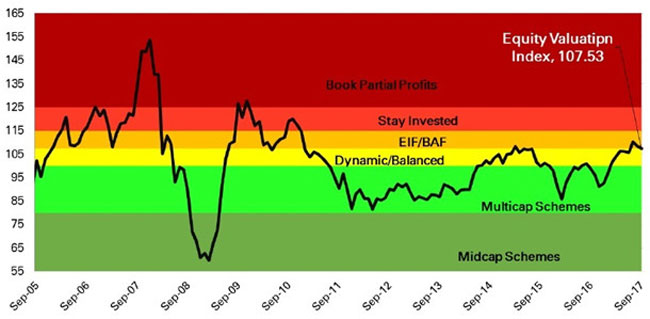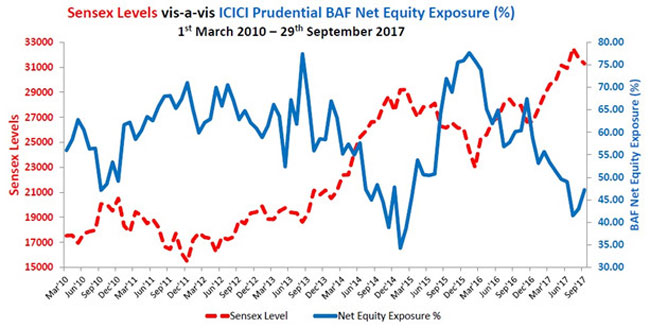|
WF: The huge success of I Pru BAF has spawned an entire category of funds in the industry that seek to dynamically buy low and sell high using different asset allocation models. Recently, some fund houses have been stressing the need to factor in market technical in addition to purely valuations (P/B or P/E) to arrive at a more balanced way to decide asset allocation. What is your perspective on this and what factors beyond P/B does your Equity Valuation Index take into account?
Chintan: The Equity Valuation Index is calculated by assigning equal weights to a variety of metrics such as Price-to-Earnings (PE), Price-to-Book (PB), Government Securities*PE, Market Cap to Gross Domestic Product ratio, to name a few.

EIF: ICICI Prudential Equity Income Fund, BAF: ICICI Prudential Balanced Advantage Fund, Dynamic: ICICI Prudential Dynamic Plan, Balanced: ICICI Prudential Balanced Fund
This index is a part of our factsheet which provides an indication of where the market is currently and thereby guiding distributors and investors as to which are the avenues an investor can consider investing in that particular phase. The equity market valuations as displayed by the index (as on September 2017) shows that market valuations are in a zone wherein investors are recommended to invest in dynamic asset allocation schemes.
WF: Your monthly market outlook presentation brings out clearly the differences between a classic cycle top scenario vs where we stand today, and therefore argues the case for us currently being in mid-cycle. Given the highly depressed numbers on most parameters, could it however be a case of the business cycle actually being in early stage while the market has run away into the next zone on the back of liquidity? Is there a risk of a significant mean reverting correction that brings the market perhaps closer to where the economy is?
Chintan: Equity market typically goes through various cycles which typically starts with a bust moves on to best, boom phase and finally enters the bubble phase. In the illustration given below, we can see the timelines of the various market phases.

Source: Internal
Currently, we believe that the Indian equity market is in a mid-cycle and has not yet reached the bubble phase as there is still no sign of over-heating in the market at a cyclical level, which reflects in low-capacity utilization. The same can be said across various macro indicators which are listed below.

At current market levels, a revival in corporate earnings is already priced in. We believe over the next two years, a secular growth in corporate earnings is likely to play out as the transient effect of the various reforms will come to pass. At the same time, if earnings were to come too quickly, there is a danger that investors may tend to extrapolate on high earnings and make their biggest mistakes. As Seth Klarman says- Bubbles get formed when there are excellent fundamentals with irrational extrapolation. A mean reversion may happen only if earnings do not pan out as expected come in the near to medium term.
WF: Given the current worries around a potential market correction, can you take us through how I Pru BAF has actually limited the downside during market corrections and yet captured upsides of market rallies?
Chintan: As one would be aware, ICICI Prudential Balanced Advantage Fund is designed to dynamically rebalance debt and equity based on market levels. The allocation of equities is determined by a in-house valuation model and hence there is no human discretion in the asset allocation. As on 30 Sept, 2017, the net equity exposure of the scheme stands at ~47%.
ICICI Prudential Balanced Advantage Fund's Net Equity Levelsvis-à-vis Sensex Levels

Source: BSE India & MFIE, As on 29thSeptember, 2017
The information contained herein is solely for private circulation for reading/understanding of registered Advisors/Distributors and should not be circulated to investors/prospective investors
As can be seen from the chart above, as the market rallied, profits were booked and net equity levels were lowered.
Returns Experience in All types of Market Conditions

Source: MFIE & Internal, Data as on 30thSep 2017. Past performance may or may not be sustained in future. The information contained herein is solely for private circulation for reading/understanding of registered Advisors/Distributors and should not be circulated to investors/prospective investors
3 Years Rolling Return on Daily Basis (% CAGR)

Source: MFIE, Period: 1stMarch 2010 (Investment Date) or 1st March 2013 (First Observation Date) to 29thSeptember 2017. Past performance may or may not be sustained in future.The information contained herein is solely for private circulation for reading/understanding of registered Advisors/Distributors and should not be circulated to investors/prospective investors
WF: How does I Pru BAF stack up on investor expectations of higher-than-FD returns with no negative returns over any 3 year period?
Chintan: Historically, if one were to look at the data, it can be seen that the chances of a negative investment experience in this Scheme has been minimal.
3 Years Rolling Return on Daily Basis (% CAGR)

Source: MFIE, Period: 1stMarch 2010 (Investment Date) or 1st March 2013 (First Observation Date) to 29thSep 2017. Past performance may or may not be sustained in future. The information contained herein is solely for private circulation for reading/understanding of registered Advisors/Distributors and should not be circulated to investors/prospective investors
Financial Year Return Comparison

The information contained herein is solely for private circulation for reading/understanding of registered Advisors/Distributors and should not be circulated to investors/prospective investors
Latest Performance

Source: MFIE, NAV as on 29thSeptember 2017. Returns (%) are CAGR. Past performance may or may not be sustained in future.
The information contained herein is solely for private circulation for reading/understanding of registered Advisors/Distributors and should not be circulated to investors/prospective investors
WF: Can you take us through the monthly dividend + automatic withdrawal plan facility and how this can be used by investors who desire uninterrupted tax-efficient monthly cash flows from their investments?
Chintan: The option of monthly dividend + Automatic Withdrawal Plan can be considered by an investor who wishes to create a pipeline of regular cash flow. By choosing this option, the investor can receive dividend declared by the Scheme per month. In the rare case, if the Scheme does not declare a dividend; you can withdraw 0.75% of your net asset value under the Automatic Withdrawal Plan. For example: Rs 10 lac in a year, may typically generate a cash flow of 9% p.a. of the Capital Invested which is Rs. Rs90,000.
Illustration: On Rs. 10 lac investment made on 01-October-2014

*Valuation as on 29th September 2017. Internal data Computation. The above simulation is for illustration purposes only. ICICI Prudential Mutual Fund/AMC does not provide assurance or guarantee of performance of AWP feature. Past performance may or may not be sustained in future. Investment in Mutual Funds is subject to market and various other risks and there are various factors that can impact the performance of this feature. It is advisable to consult with your financial advisor to understand the terms and conditions of this feature before investing.Tax impact is basis prevailing tax laws. STT is ignored for ease of calculation. STCG Tax is assumed to be 17.7675%(15% + 15% Surcharge + 3% Cess)for the purpose of above calculation.
The information contained herein is solely for private circulation for reading/understanding of registered Advisors/Distributorsand should not be circulated to investors/prospective investors.

Mutual Fund investments are subject to market risks, read all scheme related documents carefully.
The information contained herein is only for the reading/understanding of the registered Advisors/Distributors and should not be circulated to investors/prospective investors. All data/information in this material is specific to a time and may or may not be relevant in future post issuance of this material. ICICI Prudential Asset Management Company Limited (the AMC) takes no responsibility of updating any data/information in this material from time to time. The AMC (including its affiliates), ICICI Prudential Mutual Fund (the Fund), ICICI Prudential Trust Limited (the Trust) and any of its officers, directors, personnel and employees, shall not liable for any loss, damage of any nature, including but not limited to direct, indirect, punitive, special, exemplary, consequential, as also any loss of profit in any way arising from the use of this material in any manner. The sector(s)/stock(s) mentioned in this communication do not constitute any recommendation of the same and ICICI Prudential Mutual Fund may or may not have any future position in these sector(s)/stock(s). Past performance may or may not be sustained in the future. Nothing contained in this document shall be construed to be an investment advise or an assurance of the benefits of investing in the any of the Schemes of the Fund. Recipient alone shall be fully responsible for any decision taken on the basis of this document
Share this article
|